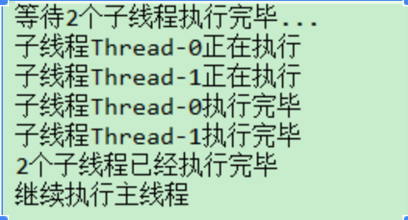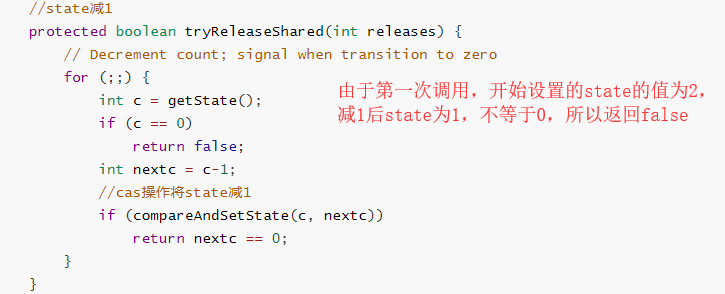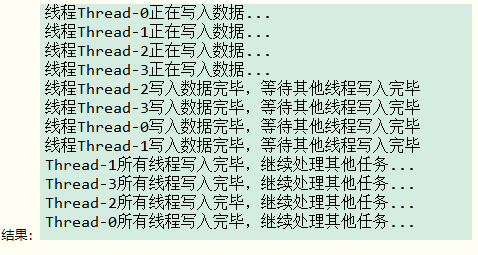CountDownLatch(计数器)使用和源码分析
CountDownLatch类位于java.util.concurrent包下,利用它可以实现类似计数器的功能。比如有一个任务A,它要等待其他4个任务执行完毕之后才能执行,此时就可以利用CountDownLatch来实现这种功能。
写个测试Demo
public class Test {
public static void main(String[] args) {
final CountDownLatch latch = new CountDownLatch(2);
new Thread(){
public void run() {
try {
System.out.println("子线程"+Thread.currentThread().getName()+"正在执行");
Thread.sleep(3000);
System.out.println("子线程"+Thread.currentThread().getName()+"执行完毕");
latch.countDown();
} catch (InterruptedException e) {
e.printStackTrace();
}
};
}.start();
new Thread(){
public void run() {
try {
System.out.println("子线程"+Thread.currentThread().getName()+"正在执行");
Thread.sleep(3000);
System.out.println("子线程"+Thread.currentThread().getName()+"执行完毕");
latch.countDown();
} catch (InterruptedException e) {
e.printStackTrace();
}
};
}.start();
try {
System.out.println("等待2个子线程执行完毕...");
latch.await();
System.out.println("2个子线程已经执行完毕");
System.out.println("继续执行主线程");
} catch (InterruptedException e) {
e.printStackTrace();
}
}
}
结果:
Demo中的主线程(main方法)为什么会等两个子线程执行countDown方法了才继续执行呢?只能从CountDownLatch的源码中找答案
CountDownLatch countDownLatch = new CountDownLatch(2); //新建计数器 个数为2个
countDownLatch.countDown(); //个数减1
countDownLatch.await(); //await
CountDownLatch的构造方法
public CountDownLatch(int count) {
if (count < 0) throw new IllegalArgumentException("count < 0");
this.sync = new Sync(count);
}
Sync类
private static final class Sync extends AbstractQueuedSynchronizer {
private static final long serialVersionUID = 4982264981922014374L;
//将父类AbstractQueuedSynchronizer中的state的值设置为2
Sync(int count) {
setState(count);
}
//获得state的值
int getCount() {
return getState();
}
//如果state为0,返回1,否则返回-1
protected int tryAcquireShared(int acquires) {
return (getState() == 0) ? 1 : -1;
}
//state减1
protected boolean tryReleaseShared(int releases) {
// Decrement count; signal when transition to zero
for (;;) {
int c = getState();
if (c == 0)
return false;
int nextc = c-1;
//cas操作将state减1
if (compareAndSetState(c, nextc))
return nextc == 0;
}
}
}
countDownLatch.countDown()执行
public void countDown() {
sync.releaseShared(1);
}
public final boolean releaseShared(int arg) {
if (tryReleaseShared(arg)) {
doReleaseShared();
return true;
}
return false;
}
tryReleaseShared 将state的值减1

countDownLatch.await() 执行
/**
部分源码注释
Causes the current thread to wait until the latch has counted
down to zero, unless the thread is {@linkplain
Thread#interrupt interrupted}.
等待计数器为0,除非线程中断
*/
public void await() throws InterruptedException {
sync.acquireSharedInterruptibly(1);
}
//AQS类中的方法
public final void acquireSharedInterruptibly(int arg)
throws InterruptedException {
if (Thread.interrupted())
throw new InterruptedException();
//protected int tryAcquireShared(int acquires) {
// return (getState() == 0) ? 1 : -1;
//}
//tryAcquireShared就是返回(getState() == 0) ? 1 : -1的值
//原先为2,刚才减1,所以返回-1
if (tryAcquireShared(arg) < 0)
doAcquireSharedInterruptibly(arg);
}
doAcquireSharedInterruptibly 执行
/**
* Acquires in shared interruptible mode.
* @param arg the acquire argument
*/
private void doAcquireSharedInterruptibly(int arg)
throws InterruptedException {
//添加到aqs队列中
final Node node = addWaiter(Node.SHARED);
boolean failed = true;
try {
for (;;) {
final Node p = node.predecessor();
if (p == head) {
//再次检验state是否为0,true返回1,false返回-1
int r = tryAcquireShared(arg);
//显然目前是r=-1
if (r >= 0) {
setHeadAndPropagate(node, r);
p.next = null; // help GC
failed = false;
return;
}
}
//进入shouldParkAfterFailedAcquire
if (shouldParkAfterFailedAcquire(p, node) &&
parkAndCheckInterrupt())
throw new InterruptedException();
}
} finally {
if (failed)
cancelAcquire(node);
}
}
shouldParkAfterFailedAcquire 执行
private static boolean shouldParkAfterFailedAcquire(Node pred, Node node) {
int ws = pred.waitStatus;
//ws目前为0,而Node.SIGNAL为-1
if (ws == Node.SIGNAL)
/*
* This node has already set status asking a release
* to signal it, so it can safely park.
*/
return true;
if (ws > 0) {
/*
* Predecessor was cancelled. Skip over predecessors and
* indicate retry.
*/
do {
node.prev = pred = pred.prev;
} while (pred.waitStatus > 0);
pred.next = node;
} else {
/*
* waitStatus must be 0 or PROPAGATE. Indicate that we
* need a signal, but don't park yet. Caller will need to
* retry to make sure it cannot acquire before parking.
*/
//通过cas把pred的waitStatus设置为-1
compareAndSetWaitStatus(pred, ws, Node.SIGNAL);
}
return false;
}
parkAndCheckInterrupt 执行
/**
* Convenience method to park and then check if interrupted
*
* @return {@code true} if interrupted
*/
private final boolean parkAndCheckInterrupt() {
//当前线程挂起
LockSupport.park(this);
return Thread.interrupted();
}
主线程已经挂起,此时如果有其他线程再次执行 countDownLatch.countDown(),将state减为0
public final boolean releaseShared(int arg) {
if (tryReleaseShared(arg)) {
//if成立,进入doReleaseShared
doReleaseShared();
return true;
}
return false;
}
doReleaseShared 执行
private void doReleaseShared() {
//自旋
for (;;) {
Node h = head;
//此时h已经不为null,因为刚才主线程已经加入到AQS队列中
if (h != null && h != tail) {
int ws = h.waitStatus;
if (ws == Node.SIGNAL) {
if (!compareAndSetWaitStatus(h, Node.SIGNAL, 0))
continue;
//重点
unparkSuccessor(h);
}
else if (ws == 0 &&
!compareAndSetWaitStatus(h, 0, Node.PROPAGATE))
continue; // loop on failed CAS
}
if (h == head) // loop if head changed
break;
}
}
unparkSuccessor 执行
private void unparkSuccessor(Node node) {
int ws = node.waitStatus;
if (ws < 0)
compareAndSetWaitStatus(node, ws, 0);
Node s = node.next;
if (s == null || s.waitStatus > 0) {
s = null;
for (Node t = tail; t != null && t != node; t = t.prev)
if (t.waitStatus <= 0)
s = t;
}
//只要s肯定不为null
if (s != null)
//唤醒主线程
LockSupport.unpark(s.thread);
}
LockSupport.unpark(s.thread)方法唤醒了主线程,主线程继续执行,流程结束。
总结:简单的点说,new CountDownLatch(数量)就是设置AQS中state的数量,线程每次countDown则state减去1,当主线程调用await时候,如果已经为0,则继续执行,如果不为0,这park当前主线程,后面其他线程countDown时候,会判断state是否为0,如果为0,会unpark主线程,即唤醒,主线程继续执行。
CyclicBarrier 回环栅栏(模拟并发场景)
测试代码:
public class Test { public static void main(String[] args) { int N = 4; CyclicBarrier barrier = new CyclicBarrier(N); for(int i=0;i<4;i++) { new Writer(barrier).start(); } } static class Writer extends Thread{ private CyclicBarrier cyclicBarrier; public Writer(CyclicBarrier cyclicBarrier) { this.cyclicBarrier = cyclicBarrier; } @Override public void run() { System.out.println("线程"+Thread.currentThread().getName()+"正在写入数据..."); try { Thread.sleep(5000); //以睡眠来模拟写入数据操作 System.out.println("线程"+Thread.currentThread().getName()+"写入数据完毕,等待其他线程写入完毕"); cyclicBarrier.await(); } catch (InterruptedException e) { e.printStackTrace(); }catch(BrokenBarrierException e){ e.printStackTrace(); } System.out.println(Thread.currentThread().getName()+"所有线程写入完毕,继续处理其他任务..."); } } }

CountDownLatch和CyclicBarrier的比较
1.CountDownLatch是线程组之间的等待,即一个(或多个)线程等待N个线程完成某件事情之后再执行;而CyclicBarrier则是线程组内的等待,即每个线程相互等待,即N个线程都被拦截之后,然后依次执行。
2.CountDownLatch是减计数方式,而CyclicBarrier是加计数方式。
3.CountDownLatch计数为0无法重置,而CyclicBarrier计数达到初始值,则可以重置。
4.CountDownLatch不可以复用,而CyclicBarrier可以复用。
附录: 相关书籍《Java并发编程的艺术》《Java多线程编程核心技术_完整版》
=========================================================================================================================================
我只是一粒简单的石子,未曾想掀起惊涛骇浪,也不愿随波逐流
每个人都很渺小,努力做自己,不虚度光阴,做真实的自己,无论是否到达目标点,既然选择了出发,便勇往直前
我不能保证所有的东西都是对的,但都是能力范围内的深思熟虑和反复斟酌







 浙公网安备 33010602011771号
浙公网安备 33010602011771号